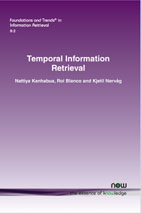Temporal Information Retrieval
By Nattiya Kanhabua, L3S Research Center, Hanover, Germany, kanhabua@L3S.de | Roi Blanco, Yahoo Labs, London, UK, roi@yahoo-inc.com | Kjetil Nørvåg, NTNU, Trondheim, Norway, Kjetil.Norvag@idi.ntnu.no
Abstract
Temporal dynamics and how they impact upon various components of information retrieval (IR) systems have received a large share of attention in the last decade. In particular, the study of relevance in information retrieval can now be framed within the so-called temporal IR approaches, which explain how user behavior, document content and scale vary with time, and how we can use them in our favor in order to improve retrieval effectiveness. This survey provides a comprehensive overview of temporal IR approaches, centered on the following questions: what are temporal dynamics, why do they occur, and when and how to leverage temporal information throughout the search cycle and architecture. We first explain the general and wide aspects associated to temporal dynamics by focusing on the web domain, from content and structural changes to variations of user behavior and interactions. Next, we pinpoint several research issues and the impact of such temporal characteristics on search, essentially regarding processing dynamic content, temporal query analysis and time-aware ranking. We also address particular aspects of temporal information extraction (for instance, how to timestamp documents and generate temporal profiles of text). To this end, we present existing temporal search engines and applications in related research areas, e.g., exploration, summarization, and clustering of search results, as well as future event retrieval and prediction, where the time dimension also plays an important role.
Temporal Information Retrieval
Temporal dynamics and how they impact upon various components of information retrieval (IR) systems have received a lot of attention in the last decade. In particular, the study of relevance in information retrieval can now be framed within the so-called temporal IR approaches, which explain how user behavior, document content, and scale vary with time, and how we can use them in our favor in order to improve retrieval effectiveness.
Temporal Information Retrieval provides a comprehensive overview of temporal IR approaches, centered on the following questions: what are temporal dynamics, why do they occur, and when and how to leverage temporal information throughout the search cycle and architecture. First, it explains the general and wide aspects associated with temporal dynamics by focusing on the web domain, from content and structural changes to variations of user behavior and interactions. Next, it pinpoints several research issues and the impact of such temporal characteristics on search; essentially regarding processing dynamic content, temporal query analysis, and time-aware ranking. It also addresses particular aspects of temporal information extraction; for instance, how to timestamp documents and generate temporal profiles of text. To this end, it presents existing temporal search engines and applications in related research areas, such as exploration, summarization, and clustering of search results, as well as future event retrieval and prediction, where the time dimension also plays an important role.
In addition to providing an extensive overview of the topic, Temporal Information Retrieval is intended to be self-contained enough to be used as teaching material for researchers who want to get acquainted with the topic. It can be read and understood by anybody with basic information retrieval knowledge but is also an ideal reference for more advanced researchers who want a deeper understanding of this field of research.
